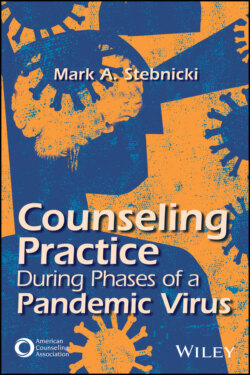Читать книгу Counseling Practice During Phases of a Pandemic Virus - Mark A. Stebnicki - Страница 15
Chapter 1 Theoretical Aspects of Risk and Resiliency During a Pandemic Virus
ОглавлениеThe purpose of this chapter is to discuss, analyze, recognize, and illustrate risk and resiliency factors that are of clinical significance in individuals seeking mental health and allied helping services during a pandemic virus. My theoretical model, called the pandemic risk and resiliency continuum (PRRC) model, is illustrated in Chapter 2. It offers a unique perspective, with two separate models: resiliency (excellent to poor resiliency) and risk (low to extreme risk), each assessed on a 5-point scale. The models of resiliency and risk each comprise four major categories of characteristics and traits: (a) mental health, (b) behavioral health, (c) psychosocial health, and (d) medical/physical health. The foundations for good mental, behavioral, and psychosocial health are explored in this chapter. The focus is on individual resiliency and risk factors observed during phases of a pandemic disaster. The intention is to enable helping professionals to anticipate, prepare for, and prevent adverse mental, behavioral, psychosocial, and health reactions.
Research generally suggests that during other natural disasters 30–50% of individuals will acquire adverse medical, physical, and psychological conditions. Short- and long-term consequences can negatively impact individuals’ overall medical, physical, and mental health and well-being. Reconceptualizing disaster mental health models and applying the results to phases of a pandemic virus will assist practitioners in appraising risk and resiliency during a pandemic virus. Ultimately, clinical researchers and practitioners may want to develop pandemic disaster prevention and intervention approaches with the intention of decreasing the mental, behavioral, and psychosocial risk factors that predispose individuals to depression, anxiety, substance use, and posttraumatic stress disorders.
The PRRC is based on extensive research in disaster mental health response; theories of trauma-informed counseling; and clinical therapeutic applications in the fields of counseling, psychology, traumatology, grief, death, and dying, which is generally reflected throughout this work (e.g., Baker & Cormier, 2015; Biddlestone et al., 2020; Boss, 2006; Dong & Bouey, 2020; Echterling et al., 2005; Fiorillo & Gorwood, 2020; Garfield, 1979; Germani et al., 2020; Lopez Levers, 2012; Manderscheid, 2007; J. E. Miller et al., 2020; Morganstein & Ursano, 2020; Muratori & Haynes, 2020; National Center for Health Statistics, 2020; Ornell et al., 2020; Pappas et al., 2009; Razai et al., 2020; Reyes et al., 2013; Shigemura et al., 2020; Shultz et al., 2016; Steardo et al., 2020; Stebnicki, 2000, 2005, 2007, 2008b, 2016a, 2017, 2018b; Stebnicki & Marini, 2016; Updegraff & Taylor, 2000; Wind et al., 2020; Worden, 2009). Additional considerations have been given to a variety of clinical observations, documented case studies, personal testimonials, and experiences of disaster and trauma survivors. Overall, the theories expressed by the PRRC theoretical model are delineated throughout the chapters of Counseling Practice During Phases of a Pandemic Virus.
